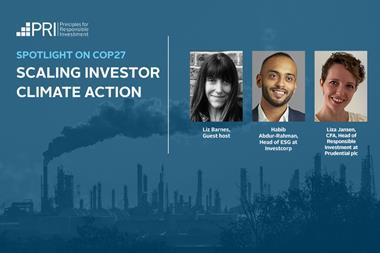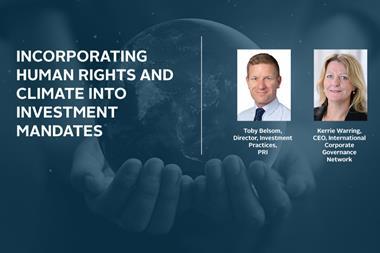Host Liz Barnes speaks with the PRI’s Sagarika Chatterjee, Director of Climate Change and COP26 High-level Champions Finance Co-Lead.
With just weeks to go until the highly-anticipated climate conference, they discuss the PRI’s policy expectations for key markets ahead of COP26, how to protect the world’s most vulnerable communities and the good news we’re expecting out of the conference.
Spotlight on CO26: what investors need to know
With Liz Barnes, journalist, and Sagarika Chatterjee, Director of Climate Change and COP26 High-level Champions Finance Co-Lead.
Note: The Principles for Responsible Investment podcast is designed to be heard. If you are unable to do this, this transcript offers an insight into the episode.
Transcripts are generated using a combination of speech recognition software and human transcribers, and may contain the occasional error. Please check the corresponding audio before quoting in print.
Subscribe to the channel via Apple podcasts, Spotify, or wherever you listen to your podcasts.
Liz Barnes
Hello and welcome to the PRI podcast and the first in our spotlight episodes around COP26, my name is Liz Barnes, and I’m delighted to be your host for these special episodes.
We can see the threat of climate change all around in the lethal storms, heatwaves, and floods in recent weeks and months. And with the world currently on track for a three to four degree temperature rise, the need to act on climate change is clear. The world is in a race to zero emissions, and we need to run further, faster. As UN secretary general, Antonio Guterres, has remarked, the alarm bells are deafening.
So, all eyes will be on Glasgow this November as leaders from 197 countries convene for the climate conference. And the year since the summit was meant to be held in 2020, the sense of urgency behind the need for rapid action on climate change has only grown. The world wants Glasgow to be a success. We need to see bold action to move towards the goals of the Paris agreement and the UN framework convention on climate change. We need to see swift and meaningful steps taken by both governments and investors to commit to having global emissions from current levels by 2030 to put the world on track for 1.5 degrees.
The PRI is focusing on convening government leaders and investors on ambitious, actionable climate targets in line with 1.5 degree warming goals agreed upon in the Paris Agreement.
Today, I’m talking to Sagarika Chatterjee, the PRI’s Director of Climate Change and a COP26 High Level Champion. We’ll be talking about the PRI’s policy expectations for key markets ahead of COP, how to protect the world’s most vulnerable communities and the good news we’re expecting out of the conference. Welcome Sagarika.
Sagarika Chatterjee
Thanks very much Liz.
Liz Barnes
So, let’s start with the PRI’s policy expectations. What are they for the key markets ahead of COP26?
Sagarika Chatterjee
I think overall, what we’re really looking to do is see that COP26 keeps 1.5 alive and within reach. And for that we really need to see not only the step-up in government ambition towards 2050, but particularly to see near term action. So obviously we can’t wake up in 2040, 2049, and go, hey, we’re getting close to 2050. We need to do something. The action has to start much, much closer than that.
Just to bring that home a little bit, we recently had the international agency net zero roadmap for 1.5, their analysis on what’s needed. And they pointed out very clearly that to reach 1.5 and keep it alive, fossil fuel phase out is inevitable. It needs to be equitable. And that means no new investment in new fossil fuel supply projects and also no further investment in new unabated coal plants. Bringing that down to near term, it also means by 2035, there should be no new sales of the internal combustion engine passenger cars. So really, really significant. So that’s overall the kind of things we need to be thinking about.
Liz Barnes
You go into a deep dive for us about some specific countries here. What about the United States, for example?
Sagarika Chatterjee
Yeah, so President Biden rejoined the Paris Agreement and committed the US to net zero by 2050, which is really fantastic. But what we have now is a very key moment at the US where they really stand out crossroads. And specifically, what we’re looking at is the US reconciliation budget, which is a once in a decade opportunity to pass very comprehensive decisive climate legislation. And particularly three policies are very important in there. So, one is around clean energy standards or payment program with real incentives for utilities to scale up their share of clean energy. The second is around clean energy tax credits and the third is around a levy on methane emissions. And if we see strong legislation, there is a much higher probability that the US will be on track and also the planet will be more on track in terms of keeping 1.5 degrees within reach.
Liz Barnes
And what about China? Let’s talk about China for a moment.
Sagarika Chatterjee
So president Xi is, you know, committed China to carbon neutrality by 2060 and peaking emissions 2030. But what we would really need to see in the near term is policies that are much stronger around emissions reductions in power, in industry, road transport and effective carbon pricing mechanism, including reforming the emissions trading scheme to tighten some of the benchmarks. And also, what we’d like to see from the finance side is greater focus on tighter corporate climate disclosure and raising the standards of the green taxonomy that they have. We think that a national sustainable finance strategy will be really important to China’s climate ambition.
Now there’s a big question mark as to, will President Xi make an announcement to reduce emissions further, peak emissions by 2025, either at the G20 or at COP26. We don’t know. However, it’s not necessary for China to wait until this time or to wait another five years to make policy changes. They could make the policy changes at any stage and it would make a massive difference in terms of the impact on other developing countries and the ambitions they have I think when they see China moving,
Liz Barnes
Let’s focus on a country such as Japan.
Sagarika Chatterjee
So with Japan, we’ve seen that the proposed basic energy plans going to have an uptick in renewable energy, that will go to 36% to 38% of overall power output in 2030, but we still need to see much more detailed policy mechanisms to deliver renewable generation, a reliable plan for coal phase out, and also addressing some of the social concerns that there are around nuclear that’s going to restart. And we need the goals in Japan to be science-based and technology neutral. I think our underlying theme for China and Japan is around coal phase out. And this is the big question that has to be tackled, not only by China and Japan, but also by all countries around the world. If we’re going to keep 1.5 within reach.
Liz Barnes
Let’s have a look at the front runners. The real champions of COP 26 ambition. Who are these front runners or champions?
Sagarika Chatterjee
So just thinking about the countries, I think the EU is clearly a front runner in terms of not only their own emissions reduction pledges towards net zero. But also in terms of how they’ve connected, what needs to happen in the real economy with how the finance sector can play a key part of that. And they’ve brought this together with the EU sustainable finance platform and their work on the EU taxonomy and an array of legislation we’re starting to see coming through, but they’ve also tried to join that up. So, for example, the EU sustainable finance has got an international platform where they’re sharing their insights. It’s not telling people what to do, but giving examples of how they’re looking at things. And we’ll also encourage a bit more harmonisation in terms of sustainable finance regulation or soft law that we see around the world.
Now, if I just turned from governments to where is the other action and what we expect to see at COP26, I think what’s going to be really interesting about this COP26 is that we’re going to see real economy actors.
So, corporates and finance actually moving quite fast. And that’s going to be very helpful in terms of, I think giving governments and those wavering, the confidence that they need to move forward and that there are some significant market opportunities here that real economy actors are moving forwards in, but I’d also expect to see from corporates and also from the finance sector quite clear steers in terms of where they want to see government ambition raised so that they can go even further. If I just turned to the finance sector. So, what we’ve seen over the last few months, particularly as we enter that sprint towards Glasgow in November is an upsurge in net zero commitments from finance players.
And that’s come across the banking sector. It’s come across the insurance side on both the investments and the underwriting, it’s come across from asset managers and also the asset owners. And there’s two things that really matter, I think, to the finance industry itself, also 20 policymakers, but broader stakeholders and civil society, and that’s around credibility and impact.
So how credible are these net zero commitments that are coming out of the finance sector and what kind of impact will they have in terms of the emissions reduction that’s needed and also financing the technologies. We need the sector transition that we need that the jury’s still out on how credible and how impactful are the finance sector commitments. But one thing I think has helped drive a bit of upwards convergence has been a UN campaign that’s been run called Race to Zero, and about 250 financial institutions joined the Race to Zero campaign.
I think it’s now over 3,000 corporates, a really significant number have joined it. The point of that UN campaign is we are in a race against ourselves and also, the time that we’ve got to reduce emissions and safeguard the planet, but to be a part of the Race to Zero campaign, you have to commit to setting a net zero target. And there’s some really stringent criteria around that. So there’s 250 financial institutions and 3,000 corporates that I’ve mentioned that are part of the Race to Zero campaign. They’ve all had to make a very credible net zero commitment, and that includes near term action.
I keep coming back to this because that’s what’s going to define whether or not we meet the goal of staying within 1.5. So they have to take action in the next 12 months. They have to be setting targets that are published and there’s various parameters, including around the use of offsets, what scopes are covered and how they disclose how they’re implementing their plans. So, I think a lot of that will be elevated at Glasgow. What’s also interesting is that at COP in Glasgow in parallel to the negotiations, there will be thematic days and those thematic days will cover areas such as nature. They’ll also cover finance as a dedicated finance day. And so, there’ll be this constant mood music, and I think pressure from corporates and also from ambassadors for governments and the negotiators to listen to what’s happening and to step up in their ambition.
Liz Barnes
So, to me, that sounds like there’s quite a lot of good news to come from COP.
Sagarika Chatterjee
I think there is good news, from the real economy side, the real questions obviously is still around the government ambition. So, there’s not going to be a lot of negotiation at COP because most of the Paris Agreement has been negotiated. They’ve got to close the rule book. And we’re not going to, I can’t imagine that the whole Paris agreement is going to get ripped apart. It’s going to be a new agreement, you know, it’s, it’s the foundation that we have now for international cooperation and government commitments on reducing emissions. However, we do still need to see the country ambition level. There is significantly more ambition particularly I think from China and the sticking points are still also around developing countries. And where’s the finance going to come from and related to that some really pertinent questions around vaccinations, public health.
Do we create a sense of solidarity between developed countries and developing countries at COP? Have we been successful in the rollout of vaccines and funded quarantines? I think we will be and then also do we manage to bridge the financing gap that developing countries really feel is needed, not just for reducing emissions and mitigation, but also for adapting to the physical impacts of climate change, where we’ve got very vulnerable countries, we’ve got low lying islands, they may not be very investible today, but where is the public finance going to come from? What role can public finance, what role can the MDBs bring in more private finance, in a way that is also viable for regular traditional institutional investors in time. So I think this could be a sticking point unless we find ways for governments to mobilise the capital, ways to move, not just from the hundred billion that’s been promised to developing countries, but that’s not going to be enough in time for the next decades to come of transition. How can we get a real step change and convert that the billions that are needed into trillions that are needed for developing countries in an ambitious but realistic way?
Liz Barnes
So, what actions could investors take to get involved in COP26?
Sagarika Chatterjee
Well, I think the first thing is we need to have investors having the strong, single united voice back to governments in terms of raising ambition and seeing, much more ambition from governments at COP26 and has different forms you can use to do that, including, the PRI, we’ve got a global investor statement on climate change that hundreds of investors have signed, and we’ll be taking that to the G20 and to all parties of the Paris Agreement.
But the second area where investors can take action is with regards to their own portfolios and their own clients. And this is where we’re really encouraging investors to think about setting a net zero target. This is not easy. But the good news is you can do this with friends and take some time to do it. And the ways that you can do this is also by collaborating through one of the initiatives that PRI is convening.
So, the initiatives we have include for asset owners, the UN-convened Net Zero Asset Owner Alliance. And that involves a commitment to setting a net zero target in five-year cycles. And then for asset managers, we’ve got the Net Zero Asset Managers Initiative, and that involves committing to engaging with clients and aligning all products and services by 2050, but setting an interim target that’s around a portion of assets under management steadily looking to increase that portion and a ramp up towards 2050.
And then we’ve also got Net Zero Investment Consultants. Investment consultants obviously play a critical role and they’re committing to aligning their advice and taking other actions towards net zero, and then finally Net Zero Service Providers. And this is an alliance of a variety of service providers, again, committing to incorporating net zero within their mainstream products and services working closely with clients. And I guess the point from all this is no matter what kind of a PRI signatory, or no matter where you are in your journey, there are things you can be doing. If you’re not yet ready to set a net zero target, you can see what others are doing and start taking the steps you need to take so that you are more ready to do this over the coming months.
Liz Barnes
So, I just wanted to ask you about the PRI’s work on climate, for those who don’t know, particularly the Inevitable Policy Response, or the IPR. Can you tell us what that is?
Sagarika Chatterjee
Yeah, sure. So, the Inevitable Policy Response is a project we commissioned, I think it’s about two or three years ago now, and the reason we commissioned it, it was clear to us that financial markets are not pricing in climate risk. And it was also clear to us that investors were really lacking enough analysis on transition risk and how climate risks could play out, particularly around how could policies play out. So not just at that kind of global level, but also at a regional level with what impacts on asset classes as well. And so, we decided to commission Energy Transition Advisors and Vivid Economics to build on our thesis, that there is going to be a government response to climate change.
It could be messy. It could be late. However, when it comes, it’s going to be forceful and that would be disruptive for markets and have significant implications that this was something that investors needed to think about very deeply about what if this scenario actually played out.
So what’s happened over the last couple of years is we’ve had a lot of investor interest in this thesis and we’ve developed it into various publications, guides, analysis, that’s all available, and it goes deep into full cost policies. So, we’ve got eight policy leavers that we defined and we’re actually updating this analysis in 2021 and looking further out as well to what could be key moments after 2025, where we see a tightening of government policy. So, the way investors are using this is to try to understand climate risk and particularly to act now. So, we’ve called this the Inevitable Policy Response, but it’s not inevitable that investors will act, and we’re really urging them to think about climate risk, think about what the implications are and to step up and all of the actions they can take across their portfolio, including exercising stewardship and their corporate engagement they have underway.
Liz Barnes
And does that go back to your previous point, what you were explaining about the resilience of developing countries and people who, or companies who invest there, did those two link?
Sagarika Chatterjee
Yeah, it’s a really good point. So, with the Inevitable Policy Response in the policy forecasts, we’ve differentiated between OECD and non-OECD, so emerging, developing countries, and we think the policies will play out very differently. Just coming back to kind of the people aspects I’ll call it.
What we’ve particularly looked at an inevitable policy response is the just transition because the Energy Transition Advisors and Vivid Economics are forecasting, that there will be significant disruptions caused by policy changes. Obviously, there’s tremendous impacts then on workers, communities, and fossil fuel industries, and therefore we’ve also had separate publications. And a lot of our thinking on the Inevitable Policy Response tries to take into account, well, how could this play out? What are the just transition implications for workers and communities and what else would be needed? What we haven’t looked at as much in the inevitable policy response is the physical impacts and how we will have to finance resilience.
I think a topic that’s coming up much more this year. And so, at PRI we’re thinking about what are the implications of this in terms of how investors understand risk? How do investors start to think about these people dimensions in terms of vulnerable communities? What’s the investor role here and there’s obviously a whole bunch of other technical questions around, well, how do you look at the data, but it’s hard to assess the risk. Whenever you’re looking at social issues, it’s not an excuse, but it becomes very difficult because you can’t just assign numbers to people or the impacts on people from the physical impacts of climate change.
Liz Barnes
And what you were explaining earlier on about this resilience and protecting the world’s most vulnerable communities. I mean, what exactly do we mean by resilience? It’s a great word to use, but actually implementing that as you mentioned is incredibly difficult.
Sagarika Chatterjee
Indeed. So, there’s a whole spectrum. So I think it would, and I’m not an expert in this, I’m still getting on top of this concept myself and I would love to go out some of these countries in a fuel efficient way and understand more about what are the real issues people face. Because I think you feel very distant from it when you’re working with investors with typically dealing with spreadsheets and not with real impacts on people. So I think it would mean everything from improving the early warning systems we have through to climate resilient infrastructure through to the financing that is happening and is in place through to what happens to communities, what happens to their livelihoods? How are we making sure we’ve got the jobs of the future that also not weatherproof, but future proved in some way.
And how can we make sure that communities in, some of these regions they’re not just constantly rebuilding and rebuilding and have very limited access to insurance or safety net. So, these are the kinds of topics that I think really need to come more to the front of mind. So, I would love to be able to say we only need to focus on mitigation and reducing emissions, and obviously the best way to tackle the physical impacts is to reduce emissions in the first place. However, the physical impacts are really biting now, and it’s not just the vulnerable communities in developing countries. I mean, as you know, this is everywhere. It’s been in China where we had those images of commuters trapped on the subway. It’s been in New York where we have the terrible stories of residents in their basement flats flooding and some of the deaths that we had as well. So, this is not going to go away, and we are going to have to find better ways of making ourselves more resilient and also financing, the changes that will be needed.
Liz Barnes
Well, it sounds like there’s a lot that’s been done, but there’s also a lot to do and a lot indeed to think about. It’s almost time for us to go. But what is the one thing that you want to see personally coming out of COP?
Sagarika Chatterjee
Yeah, I think I’d really liked to see more of a sense of solidarity. And I know that word has political connotations, but for me, when I look back at the COVID experience about the, how it’s gone with the vaccines, who’s got vaccines who doesn’t have vaccines and the divisions and the potential kind of nativist agendas that have very much come up. I understand why all of that has happened, but it’s going to be critical that we can really see countries moving forwards with greater international cooperation, greater empathy. And I don’t just mean that in a soft way, but actually we need to bottom out the hard issues around common, but differentiated responsibilities on the financing angle that is needed for mitigation, for adaptation, the public, the private finance, and, really tackle this problem together, public and private actors coming together to look at how are we going to do this and make this transition and that’s me what solidarity would mean.
Liz Barnes
So Sagarika, it has been a pleasure to talk to you today and thank you very much indeed for your insights. Don’t forget you can access all the resources we discussed in the episode description, stay tuned for our next COP26 special where we’ll be looking at key outcomes from the conference.
And if you liked this episode, please do rate and subscribe. And for more information on responsible investment, go to unpri.org.
Interested in the resources discussed in this episode?
UN-convened Net-Zero Asset Owner Alliance
Net Zero Asset Managers Initiative
Downloads
Transcript: Spotlight on COP26 what investors need to know
PDF, Size 0.22 mb



















